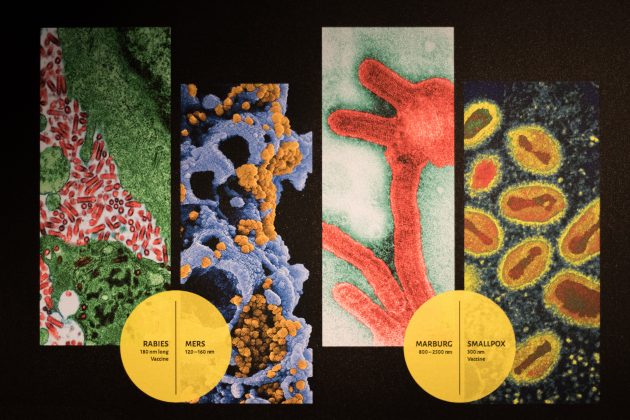What causes disease outbreaks and how can we stop them?

Microscopic images of some of the many diseases explored in “Outbreak: Epidemics in a Connected World,” an exhibition at the Smithsonian’s National Museum of Natural History on view through 2021. (Image courtesy Jeremy Snyder)
A hunter touches an infected animal’s blood, a farmer breathes the moist air exhaled by sick cows, contaminated meat is served at an outdoor market—these are a few of the ways pathogens spill over into the human population from infected animals or animal products. Viruses only replicate inside living organisms, and adapt rapidly to a new host. One infection can spread to epidemic proportions in a matter of days. Our world is more interconnected than ever before. The Smithsonian’s National Museum of Natural History offers a critical science lesson for the 21st century in the exhibition “Outbreak: Epidemics in a Connected World.” Visitors get a clear “understanding how we can prevent zoonotic viruses like Ebola, Zika and influenza from emerging and spreading around the world,” says Smithsonian anthropologist and lead curator Sabrina Sholts.

Focusing attention on the human causes of infectious disease epidemics, such as land-use change, urbanization and industrialized food production, “Outbreak” teaches the modern lesson that human, animal and environmental health are all critically linked. But how do diseases spread to begin with, and what do we know about fighting epidemics?
Sixty percent of the infectious diseases that plague humans originate with animals, and particularly with bats
Bats, which evolved 66 million years ago, are among the world’s oldest mammals and have been living with viruses a very long time. As a result, bats have adapted to viruses, don’t get sick and don’t die from them. These flying mammals are a living virus reservoir, transmitting viruses to other animals and humans.

Animals that spread disease aren’t being malicious
Viruses jump from animals to humans when people interact with animals in new ways. A virus may be perfectly benign in its host until human contact triggers an outbreak. Some 11,000 years ago, humans began to domesticate animals and live with them, which boosted the viruses we share. Today, the human population is expanding and pushing into remote ecosystems and coming into contact with animals and their often unknown pathogens in new ways—some of which may have deadly consequences.

Smallpox is the only infectious disease to be completely eradicated
One reason for this success story is that smallpox only infects humans. It has no animal reservoir in which to hide and persist.
In today’s highly connected world, the idea of a disease emerging in a faraway place and staying there is an antiquated notion
Anybody can board an airplane and be anywhere in the world in 24 hours. With such factors at play, a small epidemic today has the potential to quickly explode into a widespread pandemic with thousands of human lives at stake.
Human, animal and environmental health organizations are coming together to prevent the next outbreak

The One Health Initiative is a worldwide movement to forge collaboration and communication between physicians, veterinarians, dentists, nurses and other scientific and environmentally related disciplines. The dynamic strategy is founded on the understanding that human health, animal health and the environment are all linked. It includes the American Medical Association, American Veterinary Medical Association, the Centers for Disease Control and Prevention, the U. S. Department of Agriculture and other organizations, as well as hundreds of professionals around the globe. “Outbreak: Epidemics in a Connected World” is on view at the Smithsonian’s National Museum of Natural History in Washington, D.C. through 2021.
